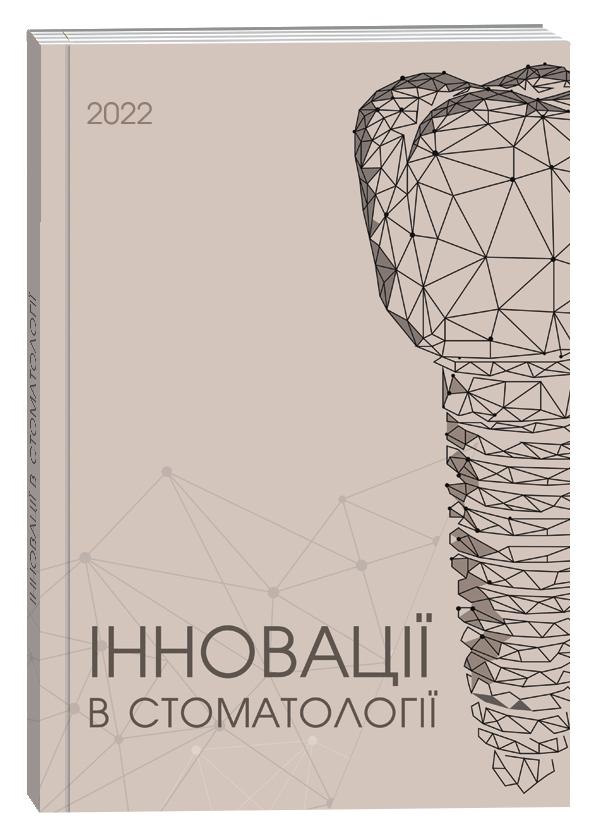PREVALENCE OF CERVICAL PATHOLOGY OF HARD DENTAL TISSUES AMONG YOUNG PEOPLE OF DONETSK REGION AND ITS RELATIONSHIP WITH MANIFESTATIONS OF PSYCHO-EMOTIONAL STRESS
DOI:
https://doi.org/10.35220/2523-420X/2022.2.4Keywords:
wedge-shaped defect, cervical caries, erosion.Abstract
Purpose of the study. The analysis of frequency and distribution of cervical lesions of teeth in young people of Donetsk region, assessment of their connection with manifestations of psycho-emotional stress. Research methods. 272 patients (average age 24.3±6.9 years) were examined for the presence of cervical pathology of the teeth and parafunctional movements of the masticatory muscles, clinical symptoms of bruxism and TMJ musclearticular dysfunction, they were asked about complaints of frequent headaches and overfatigue. The level of personal anxiety was determined using Ch.D. Spielberger State- Trait-Anxiety-Inventory in the adaptation of Y.L. Khanina. Scientific novelty. Cervical lesions of the teeth were diagnosed in 43.4% of the examined, a significant part of which were wedge-shaped defects (in 60 patients) that in 8.3% of cases were associated with enamel erosions. Cervical pathology was more common on the lower jaw: caries – on the second premolars on the left, enamel erosion and a wedge-shaped defect – on the first molars and first premolars, respectively, equally often on both sides. The depth of wedge-shaped defects significantly increased (p<0.01) with age. A weak direct relationship between the occurrence of cervical caries and gender was determined (p=0.044). Weak direct correlation was observed between the presence of complaints of overfatigue and frequent headaches and the level of personal anxiety (p<0.005). A relatively strong direct relationship between headache complaints and the level of personal anxiety was found out (p=0.005) in patients with cervical caries. Among patients with a wedge-shaped defect biting and lip licking were significantly more common, with cervical caries – TMJ muscle-articular dysfunction and bruxism (p<0.05). A direct relationship between the pathology of TMJ and masticatory muscles and the level of personal anxiety, complaints of overfatigue, and the habit of tightly clenching the teeth was determined (p<0.05). There was weak direct correlation between the presence of enamel erosion and the parafunction of clenching the teeth tightly (p=0.031). A direct relationship was observed between the clinical symptoms of bruxism and the pathology of the masticatory muscles, the habits of clenching the teeth tightly and biting and licking the lips (p<0.05). Conclusions. It is recommended to consider the identified connections between cervical lesions of the teeth and manifestations of psycho-emotional stress when developing an individual approach to treatment and preventive measures.
References
Mazur I.P., Suprunovych I.M., Novoshytskyy V.E. Cervical lesions of the teeth in patients with generalized periodontitis according to gender and age. Вісник стоматології. 2021; 1(114), 39: 2–10.
Mamaladze M., Khutsishvili L., Zarkua E. Distribution of carious and non-carious cervical lesions and gingival recession at age related aspects. Georgian Med News. 2016; 256-257: 18–23.
Nascimento M., Dilbone D., Pereira P., Duarte W.R., Geraldeli S., Delgado A.J. Abfraction lesions: etiology, diagnosis, and treatment options. Clin Cosmet Investig Dent. 2016; 8: 79–87.
Femiano F., Femiano R., Femiano L., Festa V.M., Rullo R., Perillo L. Noncarious cervical lesions: correlation between abfraction and wear facets in permanent dentition. Open Journal of Stomatology. 2015; 5: 152–157.
Орджоникидзе З.Р., Орджоникидзе Р.З., Арутюнов А.С., Брутян Л.А., Ахмедов Г.Дж., Арутюнов С.Д. Комплексная клинико-психологическая диагностика пациентов с повышенным стиранием твердых тканей зубов. Georgian Med News. 2019; 4(289): 29–36.
Герасимова Л.П., Кабирова М.Ф., Кузнецова Н.С., Фархутдинова Л.В., Хайбуллина Р.Р. Взаимосвязь функционального состояния зубочелюстной системы и психоэмоционального напряжения у лиц молодого возраста. Стоматология. 2017; 5: 34–36.
Бейнарович С. В. Исследование динамики состояния тревожности у пациентов с дислокациями суставных дисков височно-нижнечелюстных суставов и оценка эффективности ортопедического лечения этих пациентов. Кубанский научный медицинский вестник. 2018; 25(2): 35–39.
Исламова Д.М. Оптимизация методов диагностики и лечения клиновидных дефектов зубов и симптома гиперестезии зуба : автореф. дис. … канд. мед. наук : спец. 14.01.14 «Стоматология». Уфа, 2013. 22 с.
Kolak V., Pešić D., Melih I., Lalović M., Nikitović A., Jakovljević A. Epidemiological investigation of non-carious cervical lesions and possible etiological factors. J Clin Exp Dent. 2018; 10(7): e648–e656.
Levrini L., Di Benedetto G., Raspanti M. Dental wear: a scanning electron microscope study. BioMed Research International. 2014; (10), Article ID 340425.
Satheesh B. Haralur, Abdulrahman Saad Alqahtani, Mohammed Shaya AlMazni, Mohammad Khalid Alqahtani. Association of non-carious cervical lesions with oral hygiene habits and dynamic occlusal parameters. Diagnostics (Basel). 2019; 9(2): 43.
Zahra Jafari. The study of possible factors related to Non-Carious Cervical Lesions. European Journal of Academic Essays. 2014; 1(4): 45–48.
Ramsay D.S., Marilynn Rothen M., Scott J., Cunha- Cruz J. Tooth wear and the role of salivary measures in general practice patients. Clin Oral Investig. 2015; 19(1): 85–95.
Zuza A., Racic M., Ivkovic N., Krunic J., Stojanovic N., Bozovic D., Bankovic-Lazarevic D., Vujaskovic M. Prevalence of non-carious cervical lesions among the general population of the Republic of Srpska, Bosnia and Herzegovina. Int Dent J. 2019; 69(4): 281–288.
Анохина А.В., Яхин К.К., Сайфуллина А.Р., Силантьева Е.Н., Абзалова С.Л. О роли психологических факторов в развитии синдрома болевой дисфункции височно-нижнечелюстного сустава. Стоматология. 2021; 100(3): 115–119.
Фосфанова Ю.С., Медведев В.Э., Фролова В.И., Дробышев А.Ю., Шипика Д.В., Кузнецов А.Н., Заславский И.Д. Психические расстройства у пациентов с заболеваниями височно-нижнечелюстного сустава: распространенность, нозологическая квалификация и терапия. Российская стоматология. 2016; 4; 3–9.








